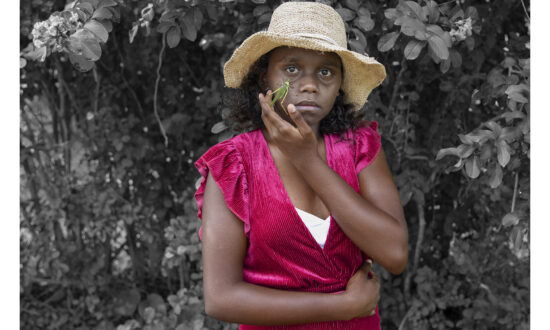“Real generosity toward the future lies in giving all to the present,” wrote Albert Camus.
For more than a decade now, all works of art that enter the Art Gallery of South Australia’s collection have been 100 per cent supported via gifts, philanthropy or fundraising. In total, 90 per cent of the collection has been made possible via private giving. The Gallery’s Foundation, bequests and membership are all avenues for this generous support.
AGSA’s recent major acquisition of Jeffrey Smart’s The Argument, Prenestina, 1982, is a significant example of this extraordinary power of private generosity. The exciting new addition draws attention to the influential lives of two towering figures in Australian art: one a philanthropist and the other an artist.
This key example of Smart’s mature work – exemplifying his unique understanding of colour, geometry, composition and scale – has been acquired to commemorate the life of the late James Ramsay AO (1923–1996). This purchase, made possible through the James and Diana Ramsay Fund, is in accordance with the wishes of James’s late wife, Diana Ramsay AO (1926–2017). As one of the nation’s greatest cultural philanthropists, it seems only fitting that James’s life be remembered through the nationally renowned work of Adelaide-born Jeffrey Smart AO (1921–2013).
For both men, 1963 was a pivotal year: James moved to Adelaide from Sydney with Diana, and Smart departed Australia for Italy. As they entered and exited Adelaide, they were both shaped by the state and, in turn, they created legacies enriching South Australia, its people and its future.

Jeffrey Smart, The Argument, Prenestina, 1982, synthetic polymer paint, oil, pencil on canvas, 120.0 x 60.0cm, James and Diana Ramsay Fund, 2022, in memory of James Ramsay AO. © Jeffrey Smart
Created in Italy in 1982, The Argument, Prenestina displays the defining qualities of Smart’s most celebrated work. With its dramatically low horizon, tilted perspective and narrow vertical format, the painting demonstrates the artist’s progressive approach to composition.
The precisely recorded scene, depicting a series of figures engaged in a roadside disagreement, also displays Smart’s confident use of colour, theatricality and wit. In the artist’s hands, the standing figures appear diminutive below the towering geometry of curved motorways. Within the setting of a busy road in Prenestina, Italy, a line of trucks – their irregular forms simplified to a series of cubes – are at a standstill in front of large multi-coloured apartment buildings.
From this detailed foreground, Smart draws the viewer’s gaze up into open pictorial space. Solid forms give way to overlapping curves, as the terracotta-pink motorways direct the viewer away from the human activity and towards a clouded blue sky.
Although Smart spent most of his life living in Italy (initially in Rome and later Arezzo, Tuscany), he remained indebted to his formative training in Adelaide. During the late 1930s and early 1940s, he studied at the Adelaide Teachers College and the South Australian School of Arts and Crafts, where he received tuition from Marie Tuck and Ivor Hele.
Smart’s visit to the studio of Adelaide modernist Dorrit Black in 1941 was particularly influential. From her home studio at Magill, in the Adelaide foothills, Black instructed Smart in the method of composing a work based on the universal mathematical principles of the golden mean. Black was the artist’s first introduction to the possibility of being a studio painter and, later in life, Smart declared her influence on his career as profound, like a “shot of adrenalin”.
The Argument, Prenestina is a key example of Smart’s mature work, which was previously unrepresented in the AGSA collection. While the gallery holds several important examples of the artist’s work, including Control Tower, c.1969, Smart’s celebrated post-1970 paintings have not been represented. Works by the artist from this period and of this quality are rarely available for acquisition.
Since his death in 2013, Smart’s works have reached close to $2 million on the open market. This acquisition, made available to the gallery through Philip Bacon Galleries, would not have been possible without the generous support of the James and Diana Ramsay Fund, launched in 2019 following bequests from both James and Diana Ramsay. This fund is a potent avenue for the growth of the gallery’s collection, dedicated purely to the acquisition of major works of art.
James’s love for the arts started early. He was born in Launceston, the son of distinguished surgeon Sir John Ramsay and the nephew of both the well-known artist Hugh Ramsay and the founder of KIWI boot polish, William Ramsay. From birth he entered a cradle of promise, opportunity and success. Yet from an early age, James witnessed his family’s thoughtful acts of philanthropy that grew into an appreciation of the transformative impact of the strategic distribution of private wealth across time.

Get InReview in your inbox – free each Saturday. Local arts and culture – covered.
Thanks for signing up to the InReview newsletter.
His personal life experiences influenced his later joint decision with his Adelaide-born wife Diana to leave bequests to AGSA. These combined bequests are regarded as one of the most remarkable Australian cultural gifts ever made.
Jeffrey Smart is famous for transforming the mundane into the extraordinary and in this way, this significant new addition becomes a metaphor for James Ramsay’s own transformative role as one of the gallery’s, and Australia’s, most generous individual donors.
The Argument, Prenestina, 1982 is on display in AGSA’s Elder Wing of Australian Art, suitably, in the James and Diana Ramsay Gallery.
Rhana Devenport, ONZM, is director of the Art Gallery of South Australia.
Support local arts journalism
Your support will help us continue the important work of InReview in publishing free professional journalism that celebrates, interrogates and amplifies arts and culture in South Australia.
Donate Here




